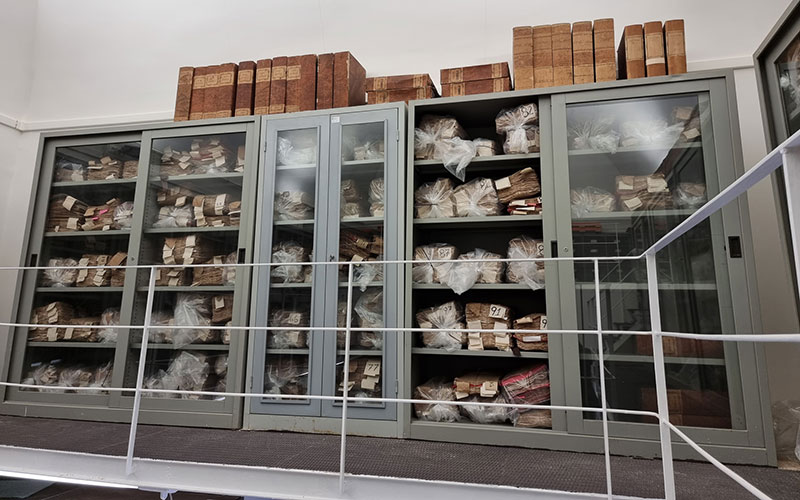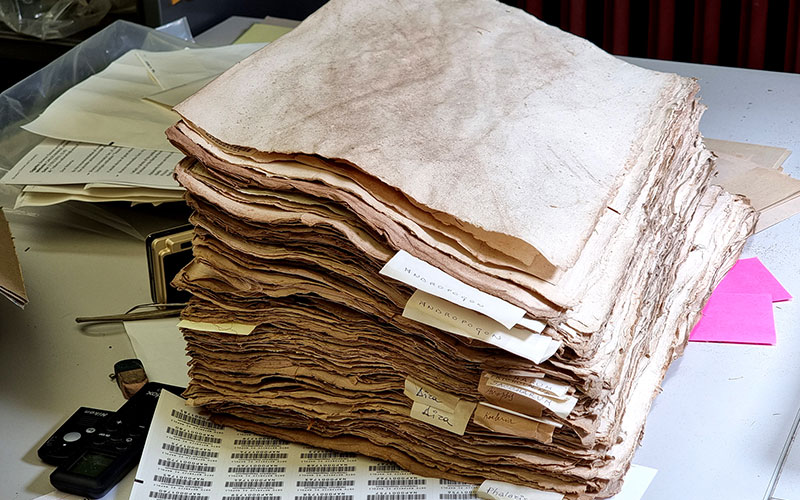The Herbarium Neapolitanum (NAP) was established in the early 19th century with the foundation of the Royal Botanical Garden (1807). The collections it houses allow tracing the developments in floristic research and botanical studies in Naples from the beginning of the 19th century to the present day, representing a significant historical and scientific heritage.
In the first half of the 19th century, botanical research, promoted by the Bourbons in Naples and driven by the remarkable organizational spirit of Michele Tenore, focused primarily on exploring the flora of the Kingdom of the Two Sicilies, which was largely unknown at the time.

These research efforts were carried out through the journeys conducted in various regions by Michele Tenore and his numerous collaborators, the foremost of whom was Giovanni Gussone. These collaborators, initially supported financially by the government during the French decade but later driven solely by their passion for botanical research, collected plants even in the most remote provinces. They would then send these plants to Tenore for further in-depth study. In addition to the plants collected by correspondents in different provinces of the Kingdom, the collections of the Herbarium Neapolitanum also include specimens gathered by Tenore and Gussone during their personal explorations on behalf of the Real Accademia delle Scienze (Royal Academy of Sciences).
These journeys undertaken by the two Neapolitan botanists were not exclusively focused on botanical investigations, but also involved the description of the locations visited and the customs of their inhabitants. This becomes evident from the accounts published by Tenore. These writings are rich in geological observations, references to the topography, meteorological data, and information on the main agricultural techniques employed by the residents of the various places visited. Examples of such publications can be found documenting expeditions in Abruzzo, Basilicata, the surroundings of Naples, and Sicily.
The specimens from the most important collections of the Herbarium Neapolitanum are still protected today in special sheets, folded at the center of the short side, made of cotton paper produced by paper mills along the Amalfi Coast (the so-called “carta bambagina”). These sheets bear the watermarks indicating the various paper mills which supplied the herbarium.

The exsiccata are accompanied by a label that provides important information about the plants. In addition to the species name, the label generally includes the collector's name, the date, and the location of collection. These pieces of information are precious in reconstructing the distribution of species.
For instance, the Herbarium preserves samples of plants that have become rare or even extinct in the locations where they could be observed in the early 19th century.
The herbaria of Tenore and Gussone not only preserve specimens of plants native in Italy but also include a wide range of rare exotic species. Tenore's role as the director of the Royal Botanical Garden brought him into contact with botanists and travelers from all over the world, leading him to study these exotic species. Giovanni Gussone's work at the Bourbon court was also significant in this regard. As the official Botanist of the Royal Household, Gussone supervised the "Royal Sites." In this capacity, he was responsible for managing the parks of Reggia di Portici, Reggia di Caserta, Reggia di Capodimonte, as well as the hunting preserves such as Astroni, Persano, and S. Silvestro. During his visits to these locations to oversee their management, Gussone never failed to collect and study the observed plants, which are still preserved in his herbarium.
In this way, the Neapolitan botanists discovered numerous new species. The specimens used to describe these species and assign them names represent the Types of those species and hold particular importance in scientific research.
| Collection | Number of fascles | Estimated number of specimens | Origin of the specimens | Collection period |
| Gussone Generale | 181 | 70.000 | Italy and elsewhere | XIX century |
| Tenore | 130 | 30.000 | Italy and elsewhere | XIX century |
| Gussone Sicilia | 104 | 12.000 | Sicily | XIX century |
| Pasquale | 104 | 10.000 | Italy and elsewhere | XIX century |
| Rigo | 49 | 9.000 | Italy and elsewhere | XIX-XX century |
| Terracciano | 81 | 6.000 | Southern Italy | XIX-XX century |
| De Toni | 65 | 5.000 | Italy and elsewhere | XIX-XX century |
| Grande | 37 | 5.000 | Central and southern Italy | XIX-XX century |
| Cavara | 140 | 5.000 | Italy and elsewhere | XIX-XX century |
| Albo | 956 | 1.500 | Sicily | XIX-XX century |

 Sistema Museale di Ateneo
Sistema Museale di Ateneo